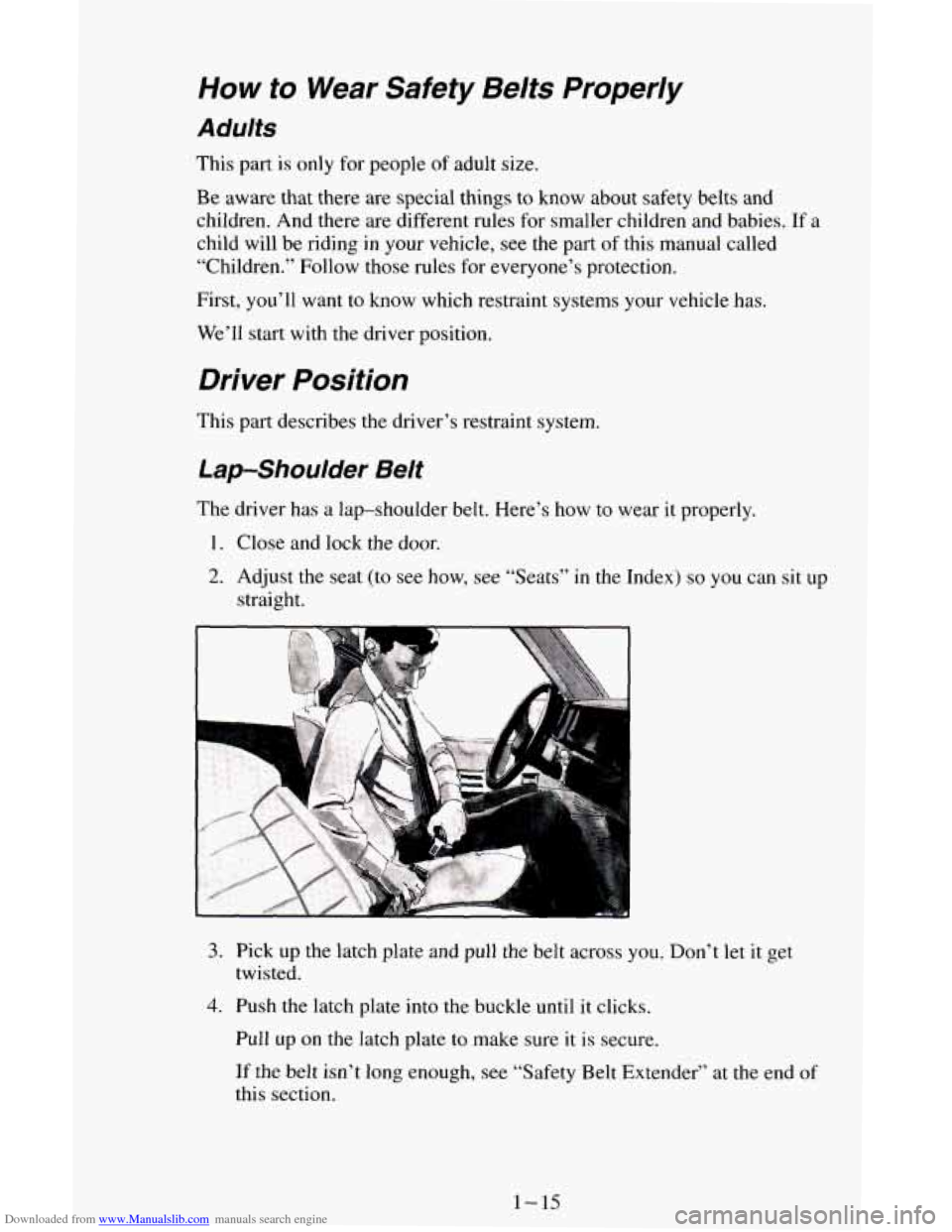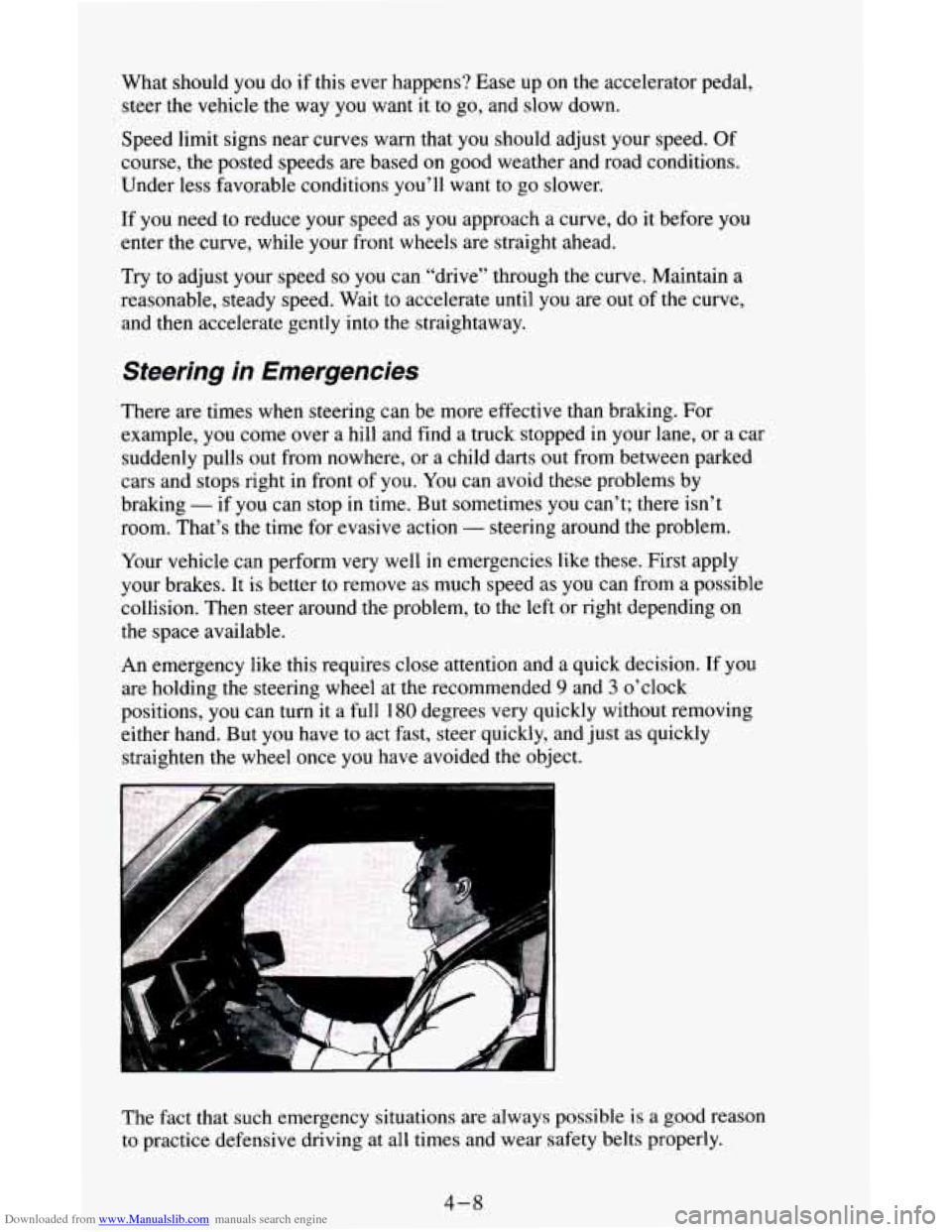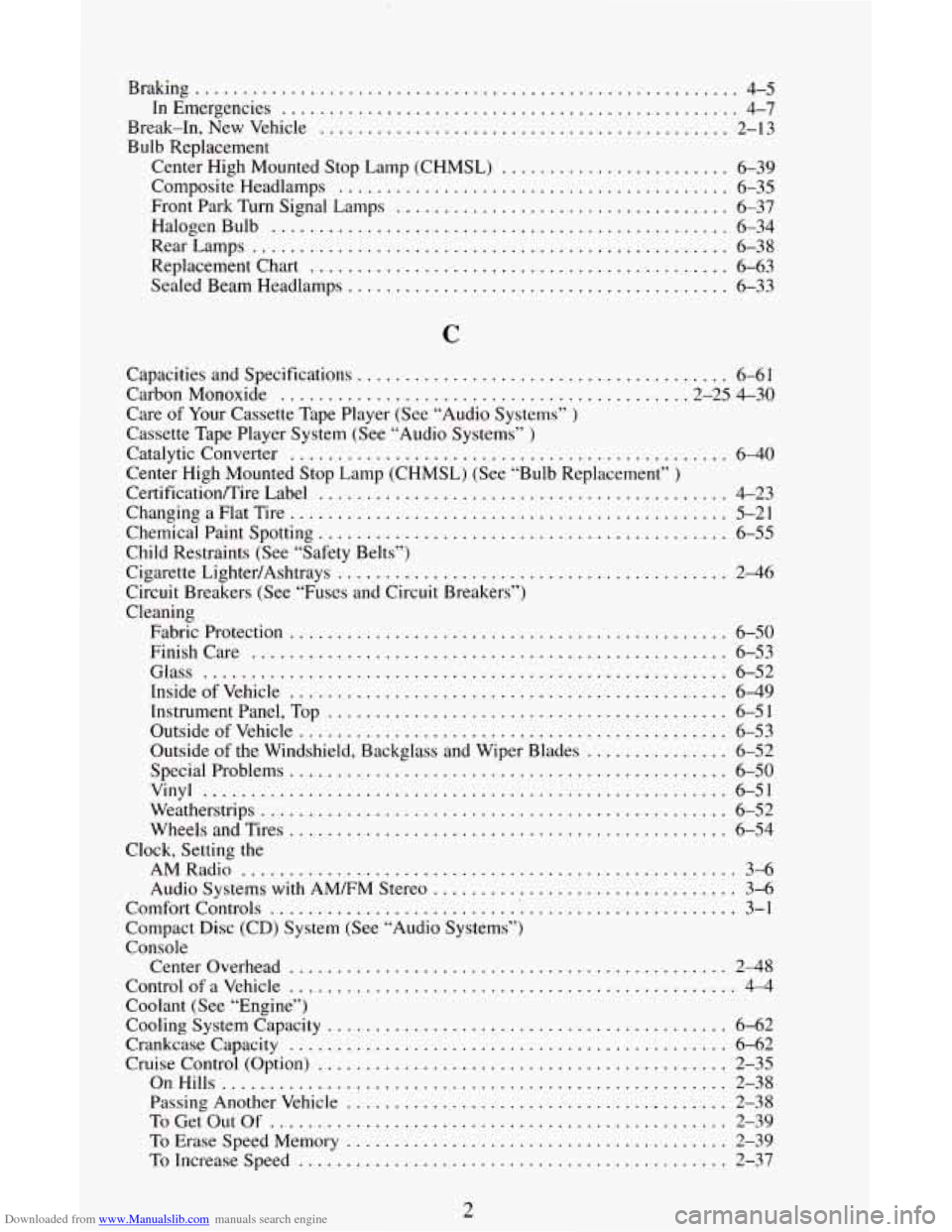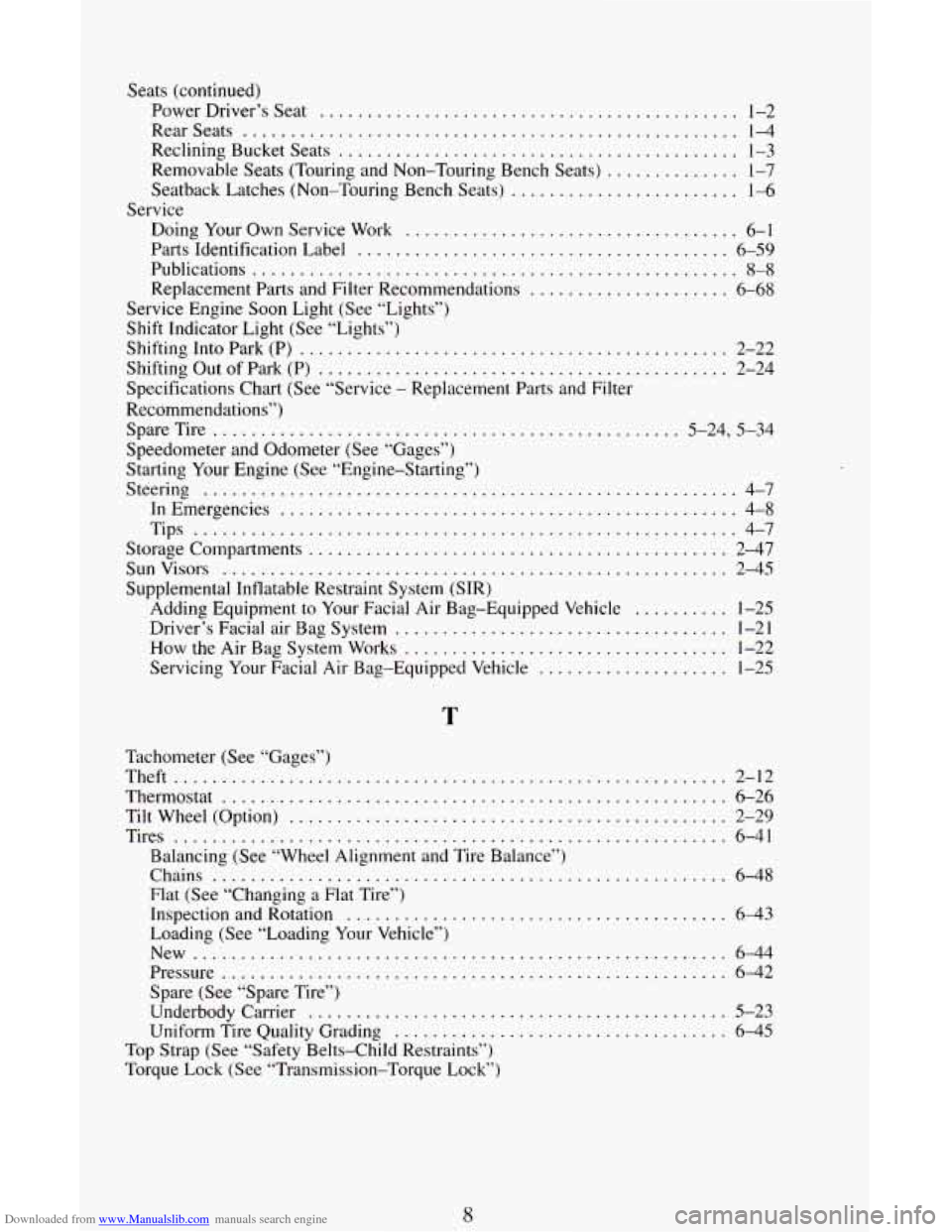child lock CHEVROLET ASTRO CARGO VAN 1995 2.G Owners Manual
[x] Cancel search | Manufacturer: CHEVROLET, Model Year: 1995, Model line: ASTRO CARGO VAN, Model: CHEVROLET ASTRO CARGO VAN 1995 2.GPages: 342, PDF Size: 17.57 MB
Page 27 of 342

Downloaded from www.Manualslib.com manuals search engine How to Wear Safety Belts Properly
Adults
This part is only for people of adult size.
Be aware that there are special things to know about safety belts and
children. And there are different rules for smaller children and babies. If
a
child will be riding in your vehicle, see the part of this manual called
“Children.” Follow those rules for everyone’s protection.
First, you’ll want to
know which restraint systems your vehicle has.
We’ll start with the driver position.
Driver Position
This part describes the driver’s restraint system.
Lap-Shoulder Belt
The driver has a lap-shoulder belt. Here’s how to wear it properly.
1. Close and lock the door.
2. Adjust the seat (to see how, see “Seats” in the Index) so you can sit up
straight.
3. Pick up the latch plate and pull the belt across you. Don’t let it get
4. Push the latch plate into the buckle until it clicks.
twisted.
Pull up
on the latch plate to make sure it is secure.
If the belt
isn’t long enough, see “Safetv Belt Extender” at the end of
this section.
1-15
Page 146 of 342

Downloaded from www.Manualslib.com manuals search engine What should you do if this ever happens? Ease up on the accelerator pedal,
steer the vehicle the way you want it to go, and slow down.
Speed limit signs near curves warn that
you should adjust your speed. Of
course, the posted speeds are based on good weather and road conditions.
Under less favorable conditions you’ll want to go slower.
If you need to reduce your speed as you approach a curve, do it before you
enter the curve, while your front wheels are straight ahead.
Try to adjust your speed so you can “drive” through the curve. Maintain a
reasonable, steady speed. Wait to accelerate until you are
out of the curve,
and then accelerate gently into the straightaway.
Steering in Emergencies
There are times when steering can be more effective than braking. For
example,
you come over a hill and find a truck stopped in your lane, or a car
suddenly pulls out from nowhere, or a child darts out from between parked
cars and stops right in front
of you. You can avoid these problems by
braking
- if you can stop in time. But sometimes you can’t; there isn’t
room. That’s the time for evasive action - steering around the problem.
Your vehicle can perform very well
in emergencies like these. First apply
your brakes. It is better to remove as much speed as
you can from a possible
collision. Then steer around the problem, to the left or right depending
on
the space available.
An emergency like this requires close attention and
a quick decision. If you
are holding the steering wheel at the recommended
9 and 3 o’clock
positions, you can turn it a full
180 degrees very quickly without removing
either hand. But you have
to act fast, steer quickly, and just as quickly
straighten the wheel once
you have avoided the object.
The fact that such emergency situations are always possible
is a good reason
to practice defensive driving at all times and wear safety belts properly.
4-8
Page 334 of 342

Downloaded from www.Manualslib.com manuals search engine Braking ......................................................... 4-5
In Emergencies
................................................ 4-7
Break-In, New Vehicle ........................................... 2-13
Bulb Replacement
Center High Mounted Stop Lamp (CHMSL)
........................ 6-39
Composite Headlamps
......................................... 6-35
Front Park Turn Signal Lamps
................................... 6-37
Halogen Bulb
................................................ 6-34
RearLamps
.................................................. 6-38
Replacement Chart
............................................ 6-63
Sealed Beam Headlamps
........................................ 6-33
C
Capacities and Specifications ....................................... 6-61
CarbonMonoxide
........................................... 2-254-30
Care of Your Cassette Tape Player (See “Audio Systems”
)
Cassette Tape Player System (See “Audio Systems’’ )
Catalytic Converter .............................................. 6-40
Center High Mounted Stop Lamp (CHMSL) (See “Bulb Replacement”
)
Certificationmire Label ........................................... 4-23
ChangingaFlatTire
.............................................. 5-21
Child Restraints (See “Safety Belts”)
Circuit Breakers (See “Fuses and Circuit Breakers”)
Cleaning Chemical Paint Spotting
........................................... 6-55
Cigarette LightedAshtrays
......................................... 2-46
Fabric Protection
.............................................. 6-50
Finishcare .................................................. 6-53
Glass
....................................................... 6-52
Insideofvehicle
.............................................. 6-49
Instrumentpanel. Top
.......................................... 6-51
OutsideofVehicle ............................................. 6-53
Outside
of the Windshield. Backglass and Wiper Blades ............... 6-52
Vinyl
....................................................... 6-51
WheelsandTires
.............................................. 6-54
AMRadio
.................................................... 3-6
Audio Systems
with AM/FM Stereo ................................ 3-6
Comfort Controls
................................................. 3-1
Compact Disc (CD) System (See “Audio Systems”)
Console Center Overhead
.............................................. 2-48
Control
of a Vehicle ............................................... 4-4
Coolant (See “Engine”)
Special Problems
.............................................. 6-50
Weatherstrips
................................................. 6-52
Clock, Setting the
Cooling System Capacity
.......................................... 6-62
Crankcase Capacity
.............................................. 6-62
Cruise Control
(Option) ........................................... 2-35
Passing Another Vehicle
........................................ 2-38
OnHills
..................................................... 2-38
ToGetOutOf
................................................ 2-39
ToEraseSpeedMemory
........................................ 2-39
ToIncreaseSpeed
............................................. 2-37
2
Page 340 of 342

Downloaded from www.Manualslib.com manuals search engine Seats (continued) Power Driver’s Seat
............................................ 1-2
Rearseats
.................................................... 1-4
Removable Seats (Touring and Non-Touring Bench Seats) .............. 1-7
Seatback Latches (Non-Touring Bench Seats) ........................ 1-6
Doing Your Own Service Work ................................... 6-1
Parts Identification Label ....................................... 6-59
Publications
................................................... 8-8
Replacement Parts and Filter Recommendations ..................... 6-68
Reclining Bucket
Seats
.......................................... 1-3
Service
Service Engine Soon Light (See “Lights”)
Shift Indicator Light (See “Lights”)
Shifting Into Park (P)
............................................. 2-22
Shifting Out of Park (P)
........................................... 2-24
Specifications Chart (See “Service
- Replacement Parts and Filter
Recommendations”) SpareTire
................................................. 5-24, 5-34
Speedometer and Odometer (See “Gages”)
Starting Your Engine
(See “Engine-Starting”)
Steering
........................................................ 4-7
InErnergencies
................................................ 4-8
Tips
......................................................... 4-7
Sunvisors
..................................................... 2-45
Supplemental Inflatable Restraint System (SIR)
Storage
Compartments
............................................ 2-47
Adding Equipment to Your Facial Air Bag-Equipped Vehicle
.......... 1-25
Driver’s Facial air Bag System
................................... 1-21
How the Air Bag System
Works .................................. 1-22
Servicing Your Facial
Air Bag-Equipped Vehicle .................... 1-25
T
Tachometer (See “Gages”)
Theft
.......................................................... 2-12
Thermostat
..................................................... 6-26
Tires
.......................................................... 6-41
Balancing (See “Wheel Alignment and Tire Balance”)
Chains
...................................................... 6-48
Flat (See “Changing a Flat Tire”)
Loading (See “Loading
Your Vehicle”)
New
........................................................ 6-44
Pressure
..................................................... 6-42
Spare (See “Spare Tire”)
Tilt Wheel
(Option)
.............................................. 2-29
Inspection and Rotation
........................................ 6-43
Underbody Carrier
............................................ 5-23
Uniform Tire Quality Grading
................................... 6-45
Top Strap (See “Safety Belts-Child Restraints”)
Torque Lock (See “Transmission-Torque Lock”)
8